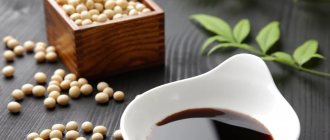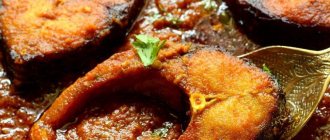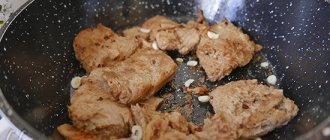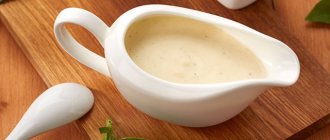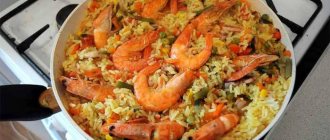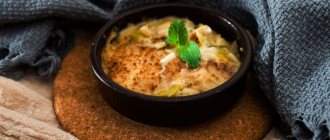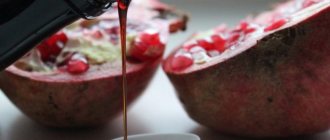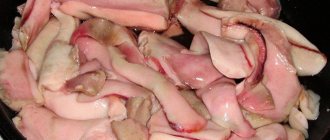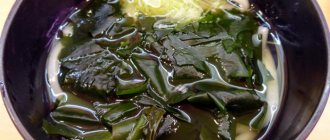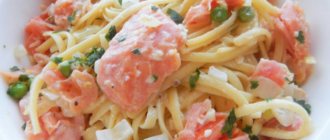2
Prepared by: Alexey Marchuk
07/07/2014 Cooking time: 15 min
| Save | I cooked) | Estimate |
You may not know, but creamy sauce goes well with a variety of seafood. For example, with fish, squid, stewed mussels, or shrimp. It turns out incredibly tasty and appetizing!
Pasta with seafood in creamy sauce
Unfortunately, seafood is an expensive pleasure these days, but it is still a pleasure. I want to offer you a dish that will really give you gastronomic pleasure and won’t put a big dent in your pocket - seafood pasta in creamy sauce.
Let me give you some advice on purchasing seafood for this dish. You can buy a ready-made seafood mixture “Seafood Cocktail”. Or you can buy all the ingredients separately:
- It is better to buy shrimps of different sizes, use several large shrimps for serving, and use small shrimps for sauce
- You can take any mussels: both with and without shells
- You can buy squid already cut into rings
Seafood pasta in creamy sauce is an easy to prepare dish, but very, very tasty. This dish is good served with a salad of fresh vegetables and washed down with dry white wine.
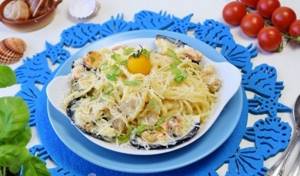
Ingredients:
- Shrimp – 250 g
- Squid – 150 g
- Mussels – 150 g
- Spaghetti – 300 g
- Onion - 1 pc.
- Basil – 5 g
- Butter - 20 g
- Garlic - 2 cloves
- Cream - 250 ml
- Parmesan cheese - 100 g
- Olive oil - 1 tsp.
- Nutmeg – 5 g
- Salt - to taste
- Pepper - to taste
Step-by-step recipe with photos:
We start preparing the dish by putting a pan of water, adding salt to it and letting the water boil. Then place the spaghetti in boiling water and cook it according to the instructions on the package. While the spaghetti is cooking, we have time to prepare the sauce. To do this, chop the garlic finely.
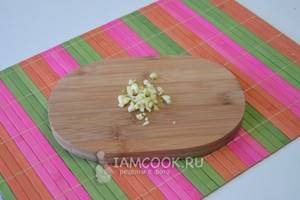
Peel the onion and cut into small cubes.
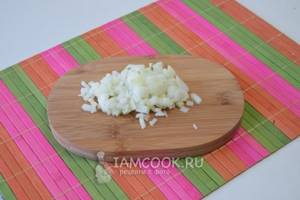
Heat butter and vegetable oil in a frying pan, add onion and garlic and fry vegetables until soft.
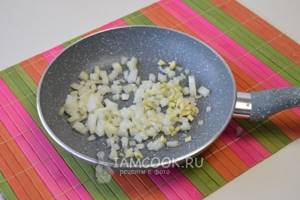
Pour cream into the pan.
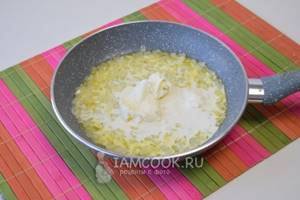
Add nutmeg.
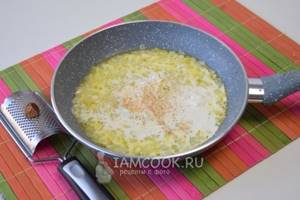
Salt and pepper the sauce to taste.
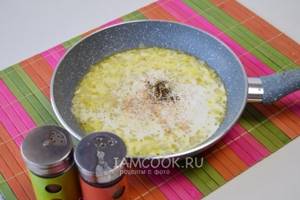
We clean the squid from films and cut into rings.
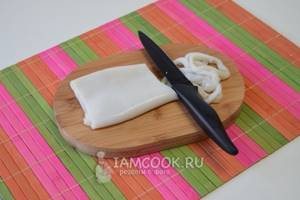
Add squid rings to the sauce.
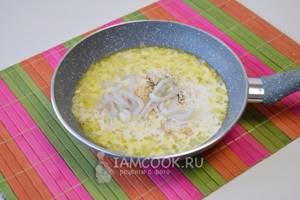
We wash the mussels under running water to get rid of grains of sand. Place the mussels in the frying pan.
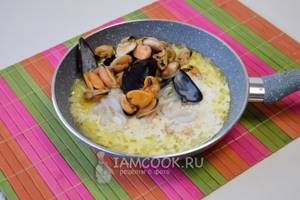
I have three types of shrimp, differing in size. We leave the tails on large shrimp, and completely remove the shells from all other shrimp.
ARTICLES ON THE TOPIC:
- Japanese seafood rice - step-by-step recipe with photos
- Pasta with oyster mushroom sauce, step-by-step recipes with photos
- Italian fish soup - recipes
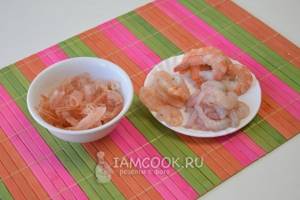
Place the shrimp in the pan and simmer the sauce for 5-8 minutes. During this time, the seafood will cook and the sauce will thicken a little. Add cheese to the sauce and mix the entire contents of the pan.
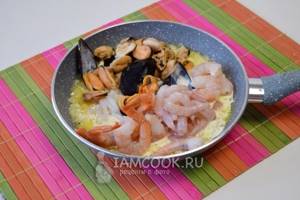
I usually cook spaghetti Al Dente, i.e. I don’t cook them a little. Drain the water from the spaghetti and return the spaghetti to the pan.
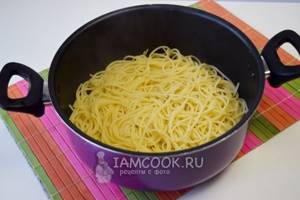
Add our creamy seafood sauce to the spaghetti. Mix all ingredients together well.
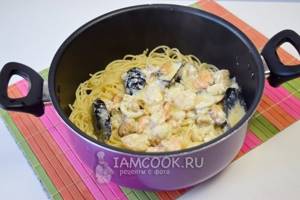
Place pasta with seafood in creamy sauce into portioned plates.
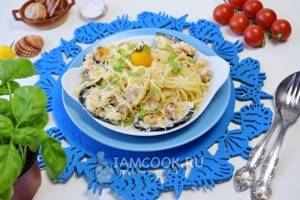
Serve plates to the table, garnished with grated cheese and fresh basil.
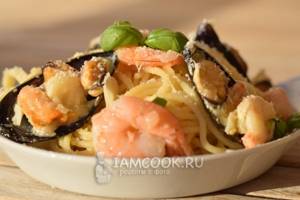
Bon appetit!
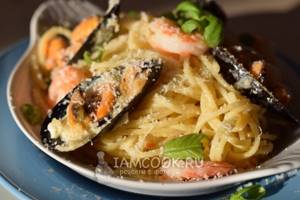
Shrimp cocktail
27 September 2011, 14:00 |
blog Cooking blog | Olga Yurkova 39 chosen
In the summer I vacationed in the city of Pavlovo. I was pleasantly surprised already on the first day. When I arrived, my relatives greeted me with a festive table. The table was on the street. Among the dishes there were many light snacks. And I liked one of them the most, as it contained my favorite shrimp. Three domestic cats rubbed themselves around us. At some point we decided to take a photo and walked a few steps away from the table. And when they returned... “Repin’s painting”: cats are sitting on the table and licking their lips - they ate shrimp from three vases!
Today I want to tell you about this exotic snack. It's called Shrimp Cocktail. Relatives shared the recipe with me.
Shrimp are rich in: iodine, sodium, potassium, calcium, sulfur, magnesium, iron, phosphorus... Shrimp meat also contains many vitamins, protein, and healthy fatty acids. Its balanced composition provides the body with a huge amount of protein, with a low fat content. Regular consumption of shrimp strengthens the cardiovascular system and promotes the growth of the child’s body.
So, for your attention:
Shrimp cocktail
Compound:
- shrimp 700 g
- grapefruit 3 pcs.
- cream 1 cup
- milk 1 glass
- flour ¼ cup
- salt 1 teaspoon
- greenery
Preparation:
To prepare the cream sauce: heat the milk and cream in a saucepan. Mix flour in a small amount of cold water. When the milk is hot, mix with flour. Cook for 5 minutes. Add salt.
Boil shrimp in lightly salted water. Then place in a colander and let dry for 10 minutes. Cleaning.
Wash grapefruits. Cut them into halves and carefully separate the core with a dessert knife.
Stuff grapefruits with shrimp. Season with cream sauce and add finely chopped herbs. We decorate our dish with lettuce leaves.
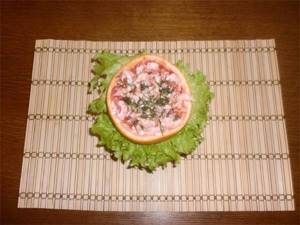
Bon appetit!
Photo by the author
Rice noodles with seafood
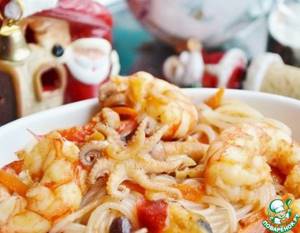
An easy healthy dish. Suitable for a festive table (especially since New Year is coming soon according to the Chinese calendar), and for every day. It is very quick and easy to prepare, and naturally brewed soy sauce gives this dish a unique taste.
Ingredients for Rice Noodles with Seafood:
- Funchoza (rice noodles) – 200 g
- Seafood (I took 150 g of each type: young octopus, peeled shrimp and mussels. Any desired, even one type) - 300 g
- Bell pepper - 1 piece
- Onion - 1 pc.
- Carrots (small) - 1 pc.
- Garlic - 2 teeth.
- Vegetable oil - 2 tbsp. l.
- Soy sauce - 4 tbsp. l.
- Lemon juice - 2 tbsp. l.
Cooking time: 40 minutes
Number of servings: 4
Recipe for Rice Noodles with Seafood:
You can take any seafood according to your desire and availability in the refrigerator. You can even have just one type, for example, just shrimp. Thawed seafood marinate for 20 minutes. In the mixture, 2 tbsp. l. soy sauce and 2 tbsp. l. lemon juice. I took TM Kikkoman soy sauce.
While the seafood is marinating, cook the rice noodles according to the instructions on the package.
Cut the onion, carrots, peppers and garlic into thin strips.
Fry the onion in vegetable oil for about 2 minutes.
Then add carrots, peppers and garlic and fry for about 2 minutes.
Add seafood and fry for about 5-7 minutes.
Add noodles, mix vigorously. Then add 2 tbsp. l. Kikkoman soy sauce. Simmer for about 2 minutes and serve immediately.
Try it, it's very tasty. Bon appetit!
Relevant products in the Online store:
VALMONT
Collagen mask-complex collagen and mucopolysaccharides
RUB 4,999
sale
Laneige
VITAMIN BRIGHTENING Micellar water with vitamins to improve complexion
from 1,995 rub.
exclusive
Dior
Miss Dior Absolutely Blooming Eau de Parfum in festive packaging
RUB 3,799
limited edition sale
Dior
Dior Addict Eau Fraiche Eau de Toilette in festive packaging
from 6,188 rub.
limited edition
All goods
Noodles with seafood
Seafood noodles - Italian pasta in a sauce with seafood. A regular assortment of frozen seafood prepared as a sauce.
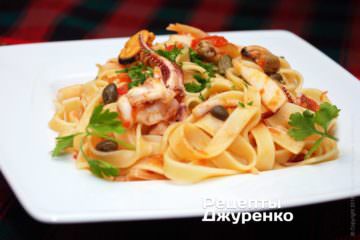
Italian cuisine is rightfully recognized as one of the best, and perhaps fashionable, in the world. It is distinguished by a huge variety of products, spices and seasonings.
Considering that Italy is a maritime country, and its shores are washed by seas rich in marine life from fish to shellfish, it is easy to assume that in Italian cuisine, seafood dishes are at the top of the list. Lovers and admirers of Italian dishes will certainly be happy with Italian pasta with seafood.
Noodles with seafood are an exceptionally tasty Italian dish, as is any pasta with seafood. Unfortunately, we only have chilled or frozen seafood available. As a rule, they are sold already packaged. It is difficult to prepare any dish from different seafood, because... packaging in small portions is rare, and buying different seafood (mussels, squid, octopus, etc.) in larger quantities is expensive.
Ingredients for seafood noodles
- Frozen seafood 250 g
- Italian noodles250 g
- Tomatoes2 pcs
- Dry white wine30 ml
- Butter 50 g
- Garlic1 clove
- Olive oil 2 tbsp. l.
- Capers 0.5 tbsp. l.
- Parsley 2-3 sprigs
- Salt, black pepper, bay leaf to taste
How to cook seafood noodles
- Pour 2-2.5 liters of water into a saucepan, add salt at the rate of 5-7 g of salt per liter and bring the water to a boil. Cook the noodles until done. You can take any noodles; Italian pasta fettuccine, pappardelle, tagliatelle, etc. are good. You need high-quality, long pasta 5-15 mm wide. Place the noodles in a colander and let the water drain.
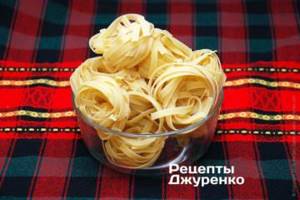
- Melt the butter in a frying pan, place the noodles in the frying pan, stir carefully, cover with a lid and place in a warm place.

- Peel and chop the onion and garlic. Simply chop the garlic with a knife and cut the onion into strips.
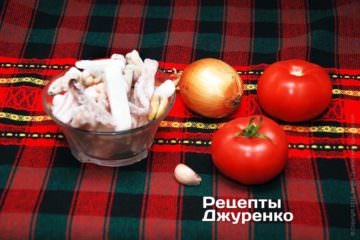
- Fry the onion for 4-5 minutes in olive oil. Add dry white wine and one bay leaf, add a little salt and pepper.
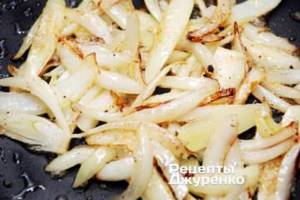
- Scald the tomatoes with boiling water, rinse with cold water and remove the skin. Remove green parts and seeds. Finely chop the tomatoes. Add garlic and tomatoes to the onions.
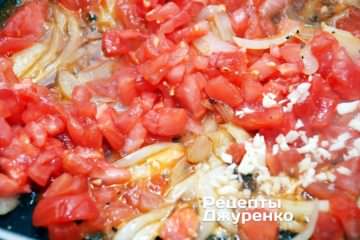
- Thaw the seafood mixture or add water and bring to a boil, then rinse. After the seafood has thawed, you can cut it into small pieces or leave it as is.
- Add seafood to the sauce made from wine, onions and spices. Simmer over low heat for 2-3 minutes. It is important not to overcook, otherwise the seafood will become like rubber.
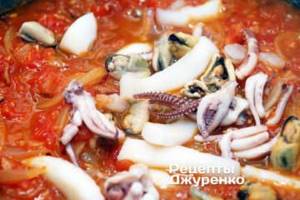
- Place noodles on a heated plate.
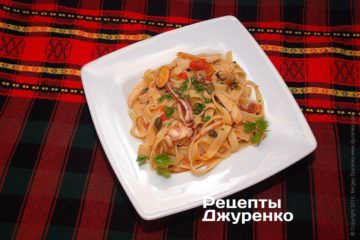
- Place the seafood mixture on the noodles, sprinkle with finely chopped parsley, add 0.5 tsp. capers and immediately serve the seafood noodles to the table.
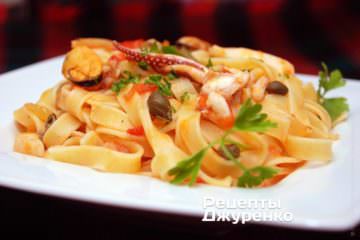
- Extraordinarily delicious noodles with seafood.
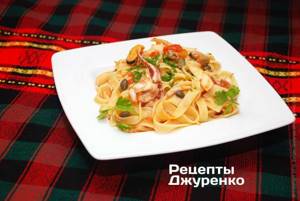
Thank you for reading!
seafood in soy sauce
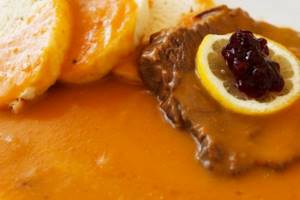
There are a lot of options for honey mustard sauce for meat, because its taste will sometimes change beyond recognition depending on the type of its two main ingredients. For example, you can experiment with the taste of honey, using flower, linden, sunflower, pine and other varieties for sauce.
To prepare the sauce, use liquid honey, but if it is heavily sugared, do not worry and under no circumstances try to melt it, say, in a water bath. Mustard is not cakes, it’s easier to prepare. When heated above 50-60 degrees, honey will lose all its beneficial properties. Even if you make a sauce from candied honey, the influence of other ingredients (mustard, lemon juice, etc.) during the stirring process will make it liquid.
The taste of the sauce will change dramatically depending on the type of mustard used - regular table mustard, spicier Russian, sweetish Bavarian, piquant Dijon or French beans.
In a word, you can look at recipes with photos and find other sauces to choose from. It is unlikely that two housewives will make the same honey and mustard sauce, and this is why it is so unique and provides a lot of scope for culinary creativity. Preparing this seasoning couldn’t be easier! See for yourself by trying one of the spicy sweet-spicy sauce options.
Honey mustard sauce with garlic
To prepare the sauce you will need:
- 2 tbsp. l. not too spicy mustard;
- 2 tbsp. l. liquid honey;
- 1 tbsp. l. freshly squeezed lemon juice;
- 2 tbsp. l. olive oil;
- 1 clove of garlic;
- ground nutmeg.
Mix honey and mustard, peel the garlic, pass through a press, add lemon juice, oil, a pinch of nutmeg and mix well with a whisk. The sauce can be served immediately or allowed to steep for a while.
Advice: it is better to cook any version of honey-mustard sauce not in iron, but in glass or earthenware containers.
Honey mustard sauce with ginger
To prepare this incredibly healthy sauce, which in addition to seasoning will also serve as an excellent “charger” for the immune system, you will need:
- 1 tbsp. l. mustard;
- 2 tbsp. l. honey;
- 1 tbsp. l. fresh lemon juice;
- 2 tbsp. l. olive or any other vegetable oil;
- a pinch of salt;
- a small slice of fresh ginger.
Peel a small piece of fresh ginger and grate it on a fine-toothed vegetable grater, which is used to puree vegetables. For this amount of ingredients, one heaped teaspoon of grated ginger is enough. Mix all ingredients until smooth and let the sauce sit in the refrigerator for about two hours. This ginger sauce is perfect for seafood.
Spicy honey mustard sauce
To prepare you will need:
- 5 tbsp. l. honey;
- 1 tbsp. l. mustard;
- 2 tbsp. l. soy sauce;
- 2 tbsp. l. olive oil;
- 1 tbsp. l. apple cider vinegar;
- a pinch of ground black pepper.
Mix honey and mustard until smooth, add olive oil and vinegar, mix thoroughly again. Add ground black pepper to the mixture, and it will taste even better if you add a freshly ground mixture of peppers. Pour in soy sauce and mix thoroughly again. The sauce can be left uninfused and served immediately. By the way, this version of the sauce can be served with fish, and not just with meat or vegetables.
Bon appetit!
Classic seafood pasta
The paste can be of any shape; “nests” were chosen to describe the classic recipe only because of their external effectiveness. Boil pasta according to the recommendations src=»https://takioki.life/images/wp-content/uploads/2019/06/pasta-s-moreproduktami-retsepty-s-foto-2.jpg» class=»aligncenter» width ="700″ height="467″[/img]
What to cook from:
- seafood cocktail – 500 g;
- spices for fish dishes;
- clove of garlic;
- a handful of chopped dill;
- nest-shaped paste – 6 pcs.;
- 250 ml low-calorie cream.
How to cook:
- The assorted seafood is put into a bag and tied. Together with it they are lowered into a pan filled with cold water. As the “cocktail” thaws, warmer tap water is added to the pan.
- The thawed mixture is washed in a colander, scalded with boiling water and placed in a saucepan. Pour in the cream, season and simmer over moderate heat until the gravy begins to thicken.
- Boil the pasta until tender, following the directions on the package, and discard. Add grated garlic to the creamy sauce and remove from heat.
- The nests are carefully transferred to portioned plates, and portions of boiled seafood are placed on top of it. Servings are sprinkled with chopped dill.
Nest-shaped pasta should be boiled while maintaining its shape. If this cannot be done carefully, simply stir the noodles and then divide into portions.
Seafood pasta in a slow cooker in creamy sauce
Most often, this dish is quickly prepared in a different, richer sauce. Due to this, it turns out no less tasty and quite interesting.
Seafood pasta in a slow cooker in creamy sauce
Ingredients:
- Italian spaghetti with cuttlefish ink - 150 g;
- black or tiger shrimps - 15 pcs.;
- mussel meat - 250 g;
- onion (large) - 1 pc.;
- garlic - 3 cloves;
- Chili pepper (fresh) - 1 pc.;
- cream from 20% fat - 250 ml;
- Refined sunflower or olive oil - 5 tbsp;
- salt - 1.5 tsp.
- pepper - to taste.
Preparation:
- Pour 2 liters of water into the multicooker bowl and set the “Steam” mode, after 15 minutes it will boil.
- We clean the seafood and rinse it under the tap in a colander. Place on a towel and place in the refrigerator.
- Add salt to boiling water. We put the spaghetti in and when it “settles” in the bowl, switch to the “Keep warm” mode, setting the timer for 7-8 minutes.
- Place the black paste in a colander, add oil (2 tbsp) and stir. Place in a container and seal to keep warm.
- Peel the peppers, remove the skins of the onions and garlic, and chop finely. Cook on the “Fry” mode, pour 3 tbsp into the bowl. oil for 5-7 minutes with the lid closed, without stirring. Place in a separate bowl and wipe the bowl with a napkin.
- Add shrimp to vegetables and fry for 3 minutes on both sides. Add mussels, cream mixed with salt and pepper. Mix carefully and switch the multicooker to the “Stew” mode, setting the timer for 20 minutes.
- When the seafood in the sauce is ready, put the spaghetti on plates, and pour the sauce and beautiful mussels and shrimp on top. Serve to the table.
Pasta goes well with fresh herbs, mushrooms and tomatoes. Therefore, you can decorate it with these products, making it truly festive. If desired, while cooking the cream, you can add your favorite cheese to it, having first crushed it.
Seafood pasta in creamy sauce is easy to prepare at home. To try “Del Mare” you don’t have to go to a restaurant; you can set a beautiful table at home and add a little romance to dinner. And for those who are on a diet, it is important to consider that the calorie content of a 100 gram serving is 205.5 kcal.
Choosing soy sauce
Soy sauce is the #1 seasoning in Asian cuisine. In any restaurant in Korea, China, Japan, Vietnam, Malaysia, Indonesia, Thailand and other Asian countries, there will always be soy sauce on the table, just like we have a salt and pepper shaker. This sauce can be used to season almost any Asian dish, from appetizers to soups. The composition of soy sauce is very simple - it is made from soybeans with the addition of salt and water. But if everything is so simple, the question arises - how to understand all the variety of soy sauces presented in the assortment of our store? In this review, we will tell you how soy sauces from Asian countries differ and how to make the right choice.
Naturally Prepared Soy Sauces vs. Hydrolyzed Sauces
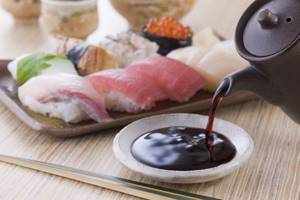
Surely you have heard a lot about the technology of making soy sauce. Traditional technology involves fermentation of soybeans. This process takes months. Every self-respecting food company in Asia chooses the natural way to produce soy sauce. The reputation of a company, especially one working for export, is crucial. Therefore, you can safely choose soy sauces from large, famous brands - just don’t forget to read the ingredients on the label. In addition to soybeans, the composition may contain wheat.
Cheap soy sauces, prepared not naturally, but chemically (from soy protein hydrolyzed with acids), are immediately recognized by a connoisseur (and even just an amateur). They have a tart smell, a pungent taste and a not very pleasant aftertaste. Such sauces are produced in just a few days, they have a very low cost, and besides, such sauces contain carcinogens that, if consumed regularly, can cause cancer. Naturally prepared soy sauce is not such an expensive product to save on.
Thanks to the fermentation process of soybeans, naturally prepared soy sauce naturally forms a salt of glutamic acid - monosodium glutamate, which gives the sauce an umami taste - a mild, pleasant taste and a long aftertaste. Umami has the property of making the taste of a dish to which soy sauce is added more vibrant. Don't be afraid of monosodium glutamate. Naturally formed, natural monosodium glutamate is found in tomatoes, broccoli, many other vegetables, mushrooms, dairy products, and meat. Glutamic acid (an amino acid that is part of the proteins of all living organisms) is present in all foods that contain protein.
Thus, naturally prepared soy sauce has a delicate, noble, appetizing aroma, a pleasant salty taste and a wonderful aftertaste.
So, the first thing to take into account when choosing soy sauce is its natural origin. By the way, even famous soy sauce manufacturers have in their assortment sauces made from a mixture of natural and hydrolyzed ones. Such soy sauces are more affordable, and their taste is well balanced. Even in Japan, which is famous for its excellent quality products, they produce such sauces, and they are in great demand.
Next we will answer the question why we choose soy sauce. There can be two options.
The first is for use as a dipping sauce and seasoning, for example, for kimbap, rolls, sushi, meat, for dressing salads, adding to a bowl of broth, noodle soup, for flavoring freshly baked fish, and so on.
The second is for use as a seasoning in the preparation of Asian dishes.
Soy sauce as a seasoning for a finished dish
If you're choosing soy sauce to use as a dipping sauce or condiment, the easiest place to go is the kitchen. If you dip Korean kimbap rolls in sauce, then look for Korean-made sauces. If you need soy sauce for dipping rolls, sashimi and sushi in it, then choose from Japanese sauces. If you like Thai, Chinese, or Vietnamese cuisine, then we choose from the producers of these countries accordingly. In our “Soy sauces” section on the website you can filter them by country of production. Korean, Japanese, Chinese, Thai, and Vietnamese soy sauces differ in color, taste, salt level, consistency and aroma.
Korean sauces for dipping and flavoring prepared dishes are called Jin Gunjang. They are sweetish, with a low level of salt, and have a mild, pleasant taste. You can start getting acquainted with Korean soy sauces Jin with Singsong and Obok sauces, prepared using the natural fermentation method. They can be used as a dip sauce for meat, fish, vegetables, rolls, and for dressing salads. An excellent soy sauce is the Sempio brand, which is very popular in Korea. Sempio soy sauces are positioned by the manufacturer as premium quality sauces, and the raw materials for the sauces have been fermented for decades. “Golden” soy sauce from the respected large Korean brand Ottogi is a tasty sauce with a pleasant aftertaste, also suitable for dipping. Its price category is slightly lower, due to the fact that it is a mixture of naturally prepared and hydrolyzed sauces. Korean Sauces Gin is the best choice for introducing soy sauces as dipping sauces.
Japanese soy sauces contain, in addition to soybeans, also wheat (often in a 1:1 ratio), and this differs from their Chinese, Korean and other counterparts. It is difficult to single out any individual brands of Japanese soy sauces - the products of each of them are tasty in their own way, and the quality is traditionally high. When choosing, it is better to focus on your own taste, as well as the composition of the product. Japanese sauces have a rich dark color, their salt level is higher than that of Korean and Chinese, and due to the presence of wheat, Japanese soy sauces have a characteristic sweetish tint. Koikuchi soy sauces are used for dipping. True, Koikuti is a universal seasoning; this sauce is also used for cooking. Almost all Japanese soy sauces (and especially those exported to other countries) are Koikuchi. Other less common sauces include Usukuchi (even saltier because it uses fermented rice) and Tamari (a wheat-free sauce popular among gluten-intolerant Japanese), but these types of soy sauces are rarely found outside of Japan. .
Separately, it is worth mentioning the choice of soy sauce for dipping Japanese rolls, sushi and sashimi in it. Did you know that in Japanese restaurants the dipping seasoning they serve you is not soy sauce? This seasoning is made from a mixture of soy sauce and mirin, a sweet Japanese cooking wine. If you are preparing homemade rolls and dipping sauce for them, mix Japanese soy sauce with mirin in a 1:1 ratio, or adjust the proportions to your taste.
As for Chinese soy sauces, they have a bright, rich taste, and their salt level is lower than that of Japanese ones. For dipping, always choose light soy sauce - this is a classic, traditional Chinese soy sauce. There is also dark (dark), but it is used only when preparing dishes (stewing, frying), it is lightly salted, the taste is almost not expressed, its main purpose is to give a deep, rich dark color to the prepared dish.
There are so-called flavored varieties of Chinese soy sauces - for example, seafood sauce, which contains powdered dried scallops and white wine. There are sauces to which garlic, or pepper, or shrimp powder, or spices are added. There is also mushroom soy sauce - with dried tsaogu mushrooms crushed into powder, it enriches stewed meat and vegetable dishes, and vegetarians use it as a substitute for oyster sauce when preparing Asian dishes.
Soy sauce as a seasoning for cooking
Korean sauces used in cooking are called Guk Ganjang. They differ from Gin sauces in their richer taste and aroma, perfectly flavor and improve the taste of the dish, even a small dosage is enough for a large volume of ingredients. At the same time, the addition of Guk soy sauces does not affect the color of the dish. Our assortment includes a large selection of Korean soy sauces Guk - for soups, for stews and fish, for frying, for guksu, for poultry and many others.
When preparing Japanese dishes, the soy sauce almost always means universal Koikuchi sauce - we have already described it in detail above. As for Chinese cuisine, Chinese recipes may require the use of both light and dark soy sauces. If a Chinese recipe (or the name of the sauce itself) does not indicate the type of soy sauce, then it is light soy sauce by default. Dark soy sauce is necessarily labeled accordingly, and is specifically mentioned in the recipe. An excessive amount of dark soy sauce can ruin the color and taste of the dish, so we recommend strictly following the dosage indicated in the recipe.
Spaghetti with seafood in creamy sauce
Seafood pasta in creamy sauce is a delicious dish often served in expensive restaurants. But the preparation is so simple that at home you can easily and very, very quickly prepare delicious spaghetti with seafood in a creamy sauce - the recipe takes only 15 minutes. This is exactly how long you will need to boil the pasta, fry the seafood with onions and garlic, and heat the creamy cheese sauce.
Ingredients
- sea cocktail (shrimp, squid, octopus, mussels) 500 g
- spaghetti 200 g
- onions 1 pc.
- garlic 2 teeth
- butter 20 g
- olive oil 1 tbsp. l.
- 50% cream 3 tbsp. l.
- parmesan cheese 50 g
- nutmeg 1 chip.
- salt and pepper to taste
Recipe for spaghetti with seafood in creamy sauce
- I start cooking by putting a pan of water on the fire. While it boils, I make the sauce at the same time. I chop the peeled onion and garlic into small cubes. Then, in a large, deep frying pan, I heat a piece of butter and a little olive oil. Fry the onion and garlic (at the same time) until soft.
- Without defrosting, I put the “sea cocktail” into the frying pan (I already have a ready-made mixture). I increase the heat to maximum so that the glaze melts faster, the liquid boils and begins to evaporate.
- I fry seafood for no more than 10 minutes, stirring with a spatula, without a lid, over high heat. This time is enough for the squid, octopus, shrimp and mussels to cook and remain tender and not hard and rubbery.
- Add cream, salt, pepper, nutmeg to the pan and heat for a couple of minutes over low heat, without bringing to a strong boil.
- I chop the cheese on a fine grater and add it to the other ingredients. After adding the cheese, the sauce immediately begins to thicken. I remove the pan from the heat.
- By this time the water is already boiling, I add salt and pasta. I boil it 1 minute less than indicated on the package so that the spaghetti turns out al dente, slightly undercooked. I discard the spaghetti and place it in the resulting sauce, stirring.
- It is advisable that the pasta with seafood in creamy sauce sit under the lid for at least 1-2 minutes, after which the dish can be served. Bon appetit!
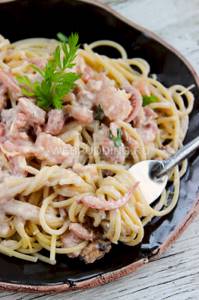
How to prepare “Sea cocktail with soy sauce”
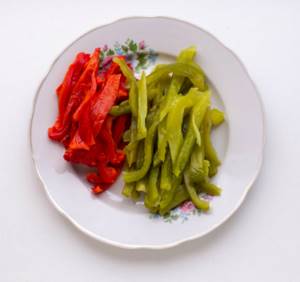
1. Bake sweet peppers in the oven, and then remove seeds and tails. Cut into thin strips.
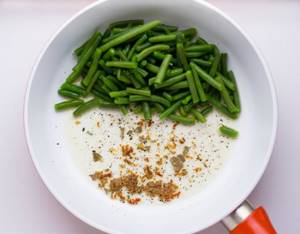
2. Place the beans in boiling water for 2-3 minutes, and then quickly drain in a colander. Place a bowl of ice under a colander to prevent the beans from losing their bright color. Pour a little oil into the pan, add spices and add beans. Warm it up for a couple of minutes.
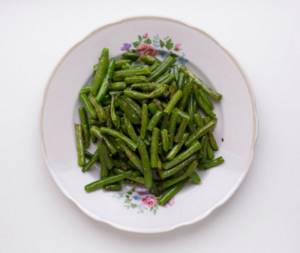
3. Place the fried beans on a plate.
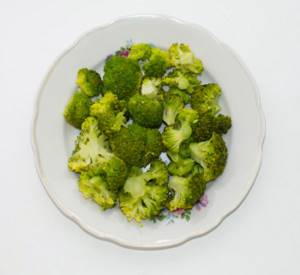
4. Place broccoli in salted boiling water. Cook for no more than 4 minutes and drain the water.
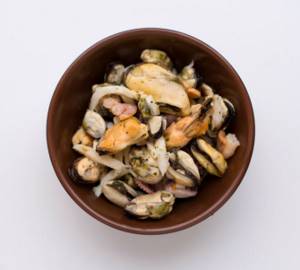
5. Boil the seafood cocktail in a separate pan. There are several options for making a seafood cocktail with soy sauce - you can boil it and then fry it in a frying pan with spices to taste.
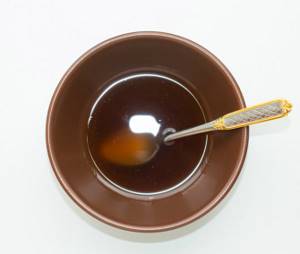
6. To prepare the dressing, you need to combine soy sauce with a small amount of honey. Add salt and pepper to taste.
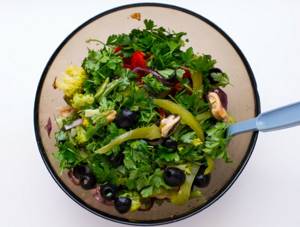
7. Pour in the dressing, mix everything carefully and the seafood cocktail with soy sauce at home with vegetables is ready to serve. You can squeeze lemon juice on top to taste.
Pasta with sea cocktail
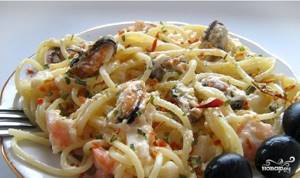
This classic recipe for pasta with sea cocktail leaves few people indifferent. It’s not surprising: the dish turns out to be truly aromatic, tender and tasty! I recommend to everyone!
Ingredients:
- “Sea cocktail” – 500 grams
- Paste – 250 grams
- Grated cheese - 200 grams
- Cream - 1 glass
- Butter - 1 tbsp. spoon
- Spices - To taste
Number of servings: 3
How to prepare “Pasta with sea cocktail”
1. Prepare the ingredients.
Boil the pasta until al dente, and defrost the seafood and boil for 10 minutes in salted boiling water. Drain water from both pasta and seafood. 2. Fry the seafood a little in butter, then add cream and grated cheese to it. Stir and simmer over low heat until cooked through. Spices - to taste. 3. Place the pasta on plates and pour the sauce over it. Ready! Sources
- https://www.iamcook.ru/showrecipe/7082
- https://www.povarenok.ru/recipes/show/83181/
- https://www.djurenko.com/cooking/osnovnye-blyuda/lapsha-c-moreproduktami.html
- https://quickdiets.ru/pasta-s-moreproduktami-retsepty-s-foto.html
- https://zen.yandex.ru/media/id/5adf7d3f7ddde81e86b72bac/firmennye-recepty-obaldennoi-pasty-s-moreproduktami-v-slivochnom-souse-5b81caa61b6c7400aa957c13
- https://webpudding.ru/spagetti-s-moreproduktami-v-slivochnom-souse/
- https://povar.ru/recipes/pasta_s_morskim_kokteilem-28517.html
[collapse]
